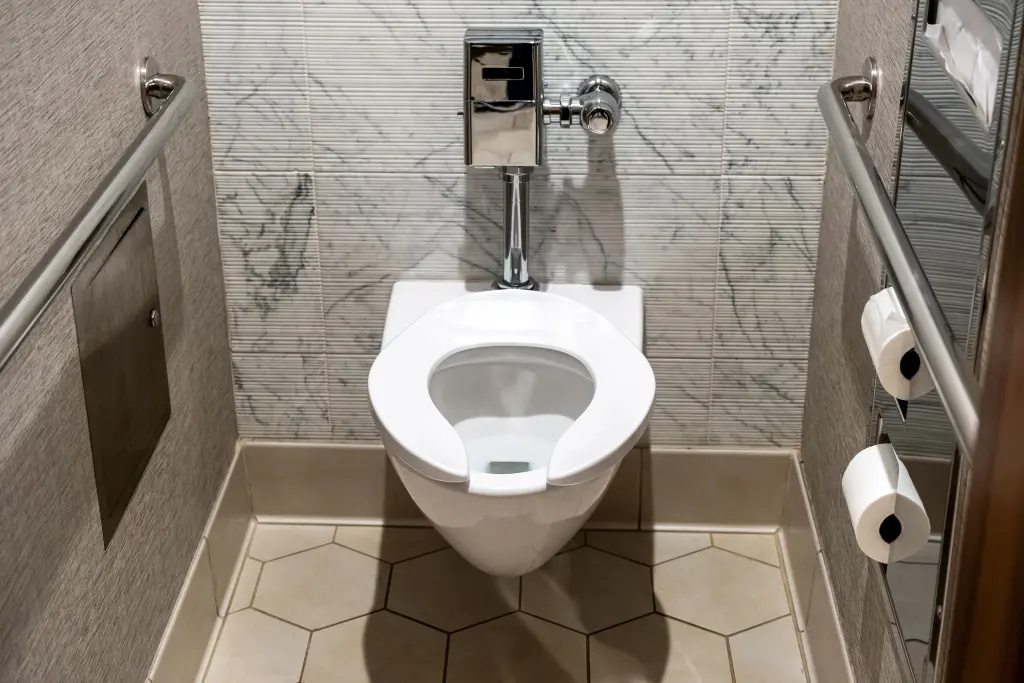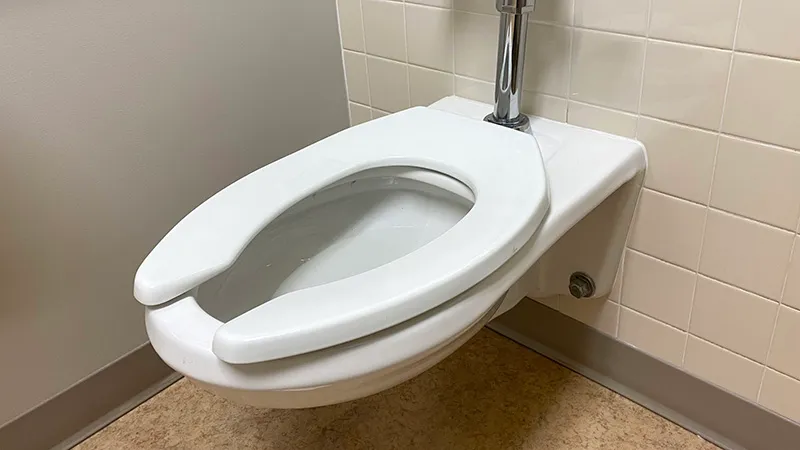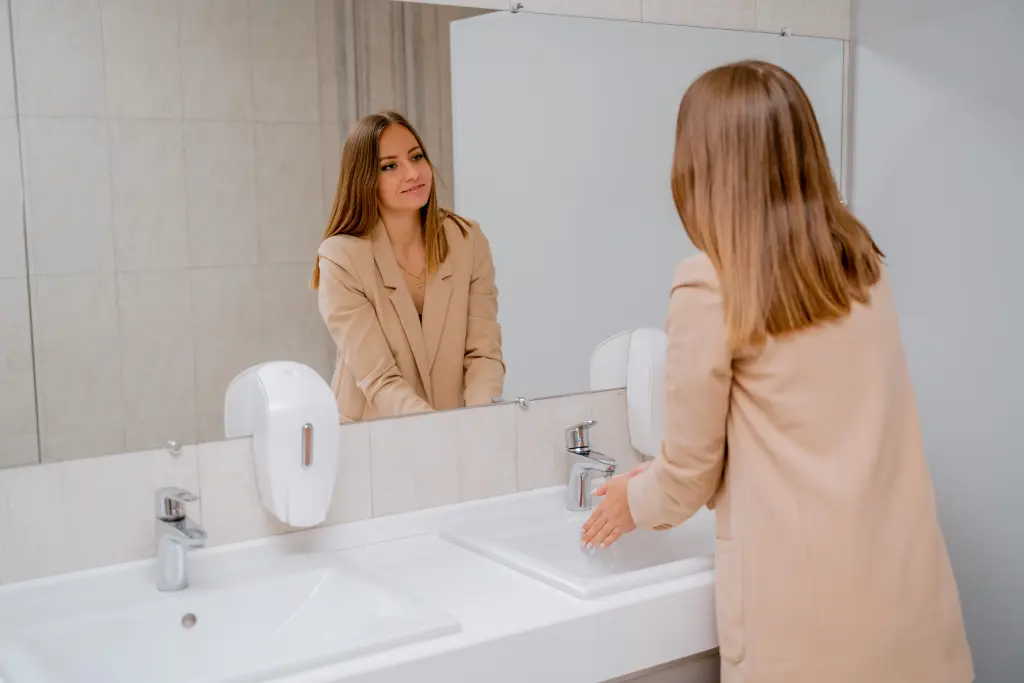Public restrooms are often avoided whenever possible, yet we’ve all had to use one at some point. You may have noticed that public toilets typically feature U-shaped, or ‘open front,’ toilet seats, while at home, your throne is likely an O-shaped, closed design. But did you know there’s a purpose behind this open-front design? Let’s dive into the fascinating world of public restroom seat shapes and explore the reasons behind this specific design.
The Purpose of the Open-Front Toilet Seat

The open-front toilet seat, sometimes referred to as the U-shaped seat, is more than just a stylistic choice for public bathrooms. This design serves practical purposes that contribute to both hygiene and user comfort. While many have speculated that it might reduce contact with bodily fluids or accommodate various body shapes, there are several reasons why these seats are favored in public restrooms.
1. Enhanced Hygiene and Cleanliness
One of the primary reasons public toilets use open-front seats is for improved hygiene. The gap at the front reduces the chances of direct contact with the seat, especially for the more sensitive parts of the body. This design can minimize the risk of contamination from the bodily fluids of previous users, providing a cleaner experience for everyone.
According to Hugo Aguilar, Senior Vice President of Codes and Standards at The International Association of Plumbing and Mechanical Officials (IAPMO), “Open front seats and elongated toilet bowls for public restrooms minimize the risk of the user coming in contact with possible contamination from a previous user.” Simply put, the open-front seat is a smart design feature that prioritizes public health.
Why U-Shaped Seats Are Required in Public Restrooms
Not only do open-front toilet seats offer improved hygiene, but they are also mandated by certain plumbing codes. In fact, the IAPMO’s Uniform Plumbing Code states that public toilets should have open-front seats to help limit direct skin contact with the seat itself. While not all states enforce this rule, it is widely followed in public restroom facilities.
2. Designed for Easy and Efficient Cleaning
Open-front toilet seats make cleaning a bit easier for restroom maintenance staff. With fewer nooks and crannies for dirt, urine, or other contaminants to accumulate, the design can be more quickly and thoroughly sanitized. A simpler cleaning process can reduce the spread of germs, making public restrooms a bit less daunting for users.
In particularly busy public restrooms, this design is a game-changer. The fewer surfaces to clean, the more efficiently janitorial staff can maintain a high level of cleanliness, ultimately improving the experience for everyone.
Improved Access and Comfort for Users
For some, using a public restroom can be an awkward experience. However, the open-front toilet seat design accommodates a broader range of users and allows for more comfortable restroom use.
3. Convenient for Female Users
The open-front design is often considered female-friendly, as it provides more room for hygienic practices. Many women find it easier to wipe front-to-back without the front portion of the seat getting in the way. This added accessibility makes the experience a little more comfortable and sanitary, particularly when dealing with crowded and less-than-ideal restroom conditions.
The American Society of Plumbing Engineers notes that the open-front seat was originally designed to accommodate this need, giving women a better restroom experience in public spaces.
4. Facilitates Different Sitting Positions
Whether people need to hover, sit, or adopt a different position, open-front toilet seats can be more accommodating. By allowing users a bit more space, the seat supports various sitting styles, especially for individuals who might prefer a slight adjustment when using the facilities. Additionally, some men find that the gap provides greater comfort as it reduces accidental contact with the seat, making the experience more comfortable.
Myths About Open-Front Toilet Seats

Despite the clear reasons for the U-shaped seat, several myths continue to circulate. Let’s debunk some of these misconceptions about open-front toilet seats in public restrooms.
Myth 1: They Are Designed to Accommodate Larger Body Sizes
While it’s true that open-front seats might be a bit more accommodating, the original purpose wasn’t strictly to fit a wider range of body shapes. The design’s focus is hygiene and access, not necessarily size inclusivity. Closed-front seats are equally effective in private settings, but for public toilets, hygiene takes precedence, thus explaining the U-shaped preference.
Myth 2: They Were Created to Conserve Materials
Some people speculate that open-front seats use less material and therefore reduce manufacturing costs. While it’s a plausible assumption, the minor difference in material is not enough to be a significant cost-saver. The primary motivators behind the design are hygiene, accessibility, and code compliance rather than cost.
Why You Shouldn’t Hover Over Public Toilet Seats
Many people prefer to “hover” over public toilet seats, fearing contact with germs. However, experts suggest that this isn’t the best approach. Dr. Poonam Desai explains that hovering can lead to urine splashes, contaminating the seat and making it messier for the next person. Moreover, this position strains the pelvic muscles, potentially leading to incomplete bladder emptying, which can contribute to discomfort or urinary issues over time.
Instead, using a toilet seat cover or toilet paper as a barrier and sitting down allows for a cleaner, more relaxed restroom experience. Dr. Desai advises, “If all of us sat on the toilet seat using a toilet seat cover, there would be less urine and feces on the toilet seat,” which makes public restrooms cleaner for everyone.
Toilet Seat Covers and Their Impact on Public Hygiene

Many public restrooms also provide seat covers, which are another line of defense against germs. If you prefer an extra layer, grab a seat cover to help keep the area clean for both yourself and others. However, remember that sitting on a public toilet seat, as long as it’s not visibly soiled, is generally safe. As Dr. Desai points out, while it may seem unappealing, the likelihood of contracting any serious illness from a public toilet seat is quite low.
Conclusion: Open-Front Toilet Seats Improve Public Restroom Hygiene

Next time you encounter a U-shaped toilet seat, you’ll know it serves a purpose beyond its appearance. Open-front toilet seats are specifically designed to reduce contact with contaminants, facilitate easier cleaning, and provide comfort and convenience for all users. While public restrooms may not be anyone’s favorite place, these thoughtful design elements help make the experience a little more sanitary.
So, the next time you use a public restroom, you can appreciate the practical reasoning behind this design and maybe even feel a little more at ease. After all, understanding the “why” can help us navigate the world—even in the most unexpected places!


